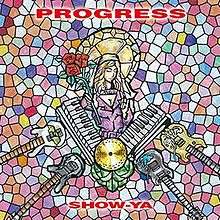Progress (Show-Ya album)
Progress is the 13th studio album by the Japanese hard rock band Show-Ya. It was released on 30 September 2015.[1] The album includes two new versions of the 1989 hit single "Genkai Lovers", one featuring Japanese celebrity Namie Amuro.
| Progress | ||||
|---|---|---|---|---|
 | ||||
| Studio album by | ||||
| Released | 30 September 2015 | |||
| Recorded | 2015 | |||
| Genre | Hard rock, heavy metal | |||
| Length | 55:51 | |||
| Language | Japanese | |||
| Label | Universal | |||
| Producer | Masanori Sasaji | |||
| Show-Ya chronology | ||||
| ||||
Track listing
- "Genkai Lovers 2015" (限界 Lovers 2015) (Keiko Terada & Miki Igarashi, Yoshihiko Andō) – 4:31
- "Byōsatsu Crazy Love" (秒殺Crazy Love) (Terada, Yukinojō Mori) – 4:15
- "Hangyaku no Flash" (反逆のフラッシュ) (Terada, Mori) – 3:54
- "Bring It Out!" (Miki Nakamura, Mori) – 4:58
- "Always on Your Side" (Terada, Marcy & Terada) – 5:34
- "Rock Love" (Terada, Yasushi Akimoto) – 3:42
- "Medusa" (Satomi Senba & Miki Tsunoda, Mori) – 3:38
- "A View After Dark" (Terada) – 4:18
- "Sign" (Terada, Mori) – 3:56
- "Show–yA" (Igarashi) – 5:42
- "Kagirinaku Haruka na Jiyū E - Go Again" (限りなくはるかな自由へ~go again~) (Igarashi, Terada) – 7:16
- "Genkai Lovers" (限界 Lovers) (Terada & Igarashi, Andō) – 4:07 (featuring Namie Amuro)
Personnel
Band members
- Keiko Terada – vocals
- Miki Igarashi – guitars
- Miki Nakamura – keyboards
- Satomi Senba – bass
- Miki Tsunoda – drums
gollark: So why do you think you can succeed while everyone else in the field has done mostly not useful things?
gollark: 1m³? 2m³?
gollark: How big?
gollark: You should contribute t o it.
gollark: https://osmarks.net/stuff/osmarkscalculator.zip
References
- "30th Anniversary オリジナル ニューアルバム『PROGRESS』好評発売中!" (in Japanese). Universal Music Group. Retrieved 2016-09-16.
This article is issued from Wikipedia. The text is licensed under Creative Commons - Attribution - Sharealike. Additional terms may apply for the media files.